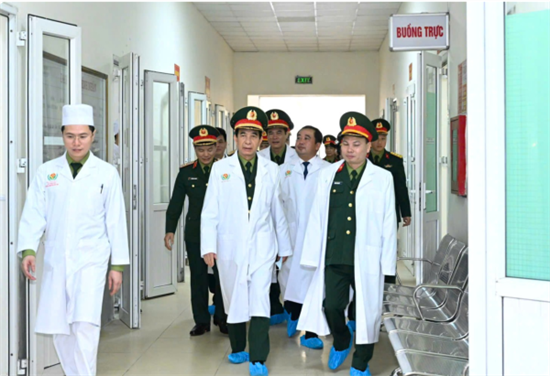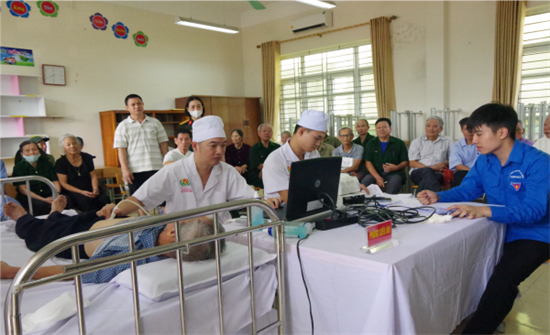Military Hospital 7 promotes digital transformation and application of science and technology to enhance medical examination and treatment capacity
Born amidst the flames of war, growing and advancing steadfastly, following Uncle Ho’s teachings
In response to the demands of the resistance war against French colonialism, on 20 October 1950, two medical units - AVT1 and AVT2, the precursors of Military Hospital 7 (now under the Logistics - Technical Department of Military Region 3), were established. Over the past 75 years of building, serving in combat, fighting, and developing, generations of cadres, doctors, employees, and soldiers of the Hospital have strived to overcome difficulties, shortages, hardships, and sacrifices. They have successfully fulfilled their assigned missions, making important contributions to the growth, maturity, and victories of the armed forces and people of Military Region 3 during the nation’s two resistance wars and in the cause of national construction and defence.
 |
| Gen. Phan Van Giang, Minister of National Defence visits the Hospital |
A special milestone in the path of building and development of the Hospital was the 30th of May 1957, when the Hospital had the honour of welcoming President Ho Chi Minh on a visit. He advised: “Our wounded and sick soldiers are those who have rendered great service to the country. Now that they have been injured or have fallen ill and come here, you, on behalf of the Party and State, must take good care of them so that they may recover quickly”. President Ho Chi Minh’s instruction has become the goal, the guiding principle, and a great source of spiritual motivation, encouraging and inspiring cadres, doctors, employees, and soldiers of the Hospital to constantly strive forward and fulfil every assigned task.
During the years of the resistance war against US imperialism for national salvation, despite fierce air and naval bombardments by the enemy and the need to evacuate repeatedly, the Hospital still managed to save and treat hundreds of thousands of wounded and sick soldiers; together with local troops and people, it contributed to firmly defending the socialist North and providing strong support for the southern front lines. After the country’s complete reunification, the Hospital continued to effectively admit, provide first aid, and treat wounded soldiers transferred from the northern border battlefields, ensuring military medical support for the armed forces of Military Region 3 according to its assigned responsibilities, achieving many new accomplishments. From its early days as small military medical teams with limited manpower and insufficient equipment, Military Hospital 7 has now grown into a Grade I, multi-speciality, top-tier hospital of Military Region 3, with a capacity of 600 patient beds. In addition to performing medical techniques within its designated level, the Hospital has also implemented advanced procedures transferred from central-level hospitals, mastering many modern and specialised techniques. In recent years, the Hospital has consistently excelled in the work of medical examination, admission, and treatment for the Military Region’s armed forces, policy beneficiaries, and local residents. It has also ensured medical support for Phan Vinh Island (Truong Sa Archipelago), participated in the United Nations peacekeeping mission in South Sudan, and taken the lead in the fight against Covid-19 pandemic. The quality of medical examination, treatment, and healthcare provided by the Hospital for both soldiers and civilians has been continually improved, affirming its prestige and credibility within the national healthcare system. In recognition of its achievements, the Hospital has been given numerous noble rewards from the Party, the State, and the Ministry of National Defence. This is a source of pride and motivation for generations of the Hospital’s staff members to uphold their glorious tradition and excellently fulfil every mission.
Promoting tradition, creating value, elevating status, and striving to build a smart Hospital
The task of protecting and caring for the health of soldiers and the people has been imposing increasingly high requirements on the military medical Sector in general, the Hospital in particular, due to the complexity of current developments of weather and epidemics. Besides, the robust development of science and technology, including the field of medicine, has created opportunities and posed major challenges for medical facilities in their professional activities. In this context, in order to successfully fulfil its assigned tasks, the Hospital’s Party Committee and Board of Directors have adopted many uniform solutions; among them, promoting digital transformation and applying science and technology have been seen as breakthrough factors to improve the capacity and the quality of medical examination, treatment, and healthcare for all target groups.
 |
| Free medical examination for policy beneficiaries at Binh Khe ward, Quang Ninh province |
In implementing these breakthroughs, the Hospital has given top priority to the training and development of high-quality human resources. Recently, the Hospital’s Party Committee and Board of Directors have directed a thorough review and accurate assessment of the current status of the contingent of officers, doctors, and employees, effective conducting personnel planning work, linking training and professional development with personnel appointment and utilisation, building a team of cadres and doctors according to the motto “pure medical ethics, sound medical knowledge, excellent medical techniques”, with necessary information technology knowledge and skills suited to the functions and tasks of each department, ward, and unit to promote digital transformation and application of modern technology in all fields of work. In the process, the Hospital has concentrated on strengthening on-site training through practical work, signing cooperation agreements with leading experts inside and outside the Military to deploy new techniques, selecting its staff members to attend refresher courses at central-level hospitals in order to improve their medical knowledge, digital skills, and proficiency in advanced medical software and digital data systems in professional activities, especially in hospital management, medical record management, clinical operations, treatment, and imaging diagnostics.
Thanks to its drastic, synchronised measures, the Hospital has built a pool of medical cadres and employees with high professional qualifications. At present, the Hospital has 23 physicians holding doctoral and level II specialist degrees, 62 physicians with master’s and level I specialist degrees, 6 pharmacists, and 2 engineers. These are important human resources that ensure the Hospital’s ability to master modern medical equipment and technology and successfully carry out complex surgical procedures, such as laparoscopic abdominal surgery, ENT endoscopic surgery, PhaCo surgery, femoral head replacement, brain surgery, urinary stone lithotripsy, Longo hemorrhoidectomy, inguinal hernia mesh placement, and shoulder arthroscopy. Each year, the Hospital provides treatment for hundreds of thousands of patients with high-quality medical services and dedicated, attentive care, leaving a positive impression on patients, promoting the image of the “Uncle Ho’s Soldiers - Military Medical Soldiers”.
At the same time, the Hospital has invested in modernising its facilities and equipment and applying digital technology in its operations. In line with its functions, duties, and approved development orientation, the Hospital has proactively prioritised resources for infrastructural development as the basis for promoting digital transformation and gradually building a “smart hospital”. To optimise investment items in the context of limited funding, the Hospital’s Party Committee and Board of Directors have regarded “sustainable development resources” as the main solution, while preparing and submitting budget estimates to higher echelons for approval. Additionally, the Hospital has organised many delegations to study and learn from “smart hospital” models at central-level hospitals.
To ensure effectiveness and suitability with pre-existing infrastructures, the Hospital has proactively chosen the approach of “modernising each department” while “modernising each building”, thus creating conditions for future system connectivity. As a result, the Hospital’s facilities and medical equipment have been continuously upgraded. In recent years, many pieces of modern hardware, such as CT scanners, 1.5 Tesla MRI systems, early detection gastrointestinal endoscopy systems, high-power percutaneous laser lithotripsy machines, hip and knee arthroscopy systems, 4D colour ultrasound machines, automatic biochemical testing machines, and various medical software programs have been put into use, thereby making breakthroughs in improving diagnostic accuracy, reducing treatment time, and lowering costs for patients.
Furthermore, the Hospital has focused on developing digital infrastructures to meet management requirements related to medical records, equipment, pharmaceuticals, and patient treatment processes. In particular, the Hospital has paid due attention to building and effectively operating an “electronic medical record” system, ensuring uniformity and accuracy, facilitating medical examination and treatment, improving data-sharing capabilities with higher-level hospitals, and connecting with the National Healthcare System. It has also invested in high-capacity transmission systems and applied advanced mobile technologies to facilitate the transmission of medical data, enabling remote diagnostic connectivity and online consultations. At the same time, the Hospital has developed and effectively operated its internal database system, forming a big data system as the basis for developing artificial intelligence applications in disease analysis, epidemic forecasting, diagnostic imaging, and clinical decision support.
 |
| 1.5 Tesla MRI system of the Hospital |
Scientific research, innovation, and technical improvement are key factors in promoting digital transformation and application of science and technology to improve the quality of medical examination and treatment. In recent years, the Hospital has focused its research on specialised fields, such as field surgery, epidemic prevention and control under conditions of large troop concentration, and adaptation to harsh environments at sea, on islands, and in border areas. To create a fundamental shift, the Hospital’s Party Committee and Board of Directors have paid due regard to raising the quality of science research and emphasised the application of advanced techniques in medical examination and treatment. Research topics have been oriented to align with the functions and duties of each professional unit, while also stressing the practical applicability of each scientific work. Moreover, the Hospital has strengthened cooperation and coordination in research with Military Medical Academy and University of Medicine and Pharmacy - Vietnam National University, Hanoi, to carry out national-level research projects, contributing to mastering new knowledge and effectively providing healthcare for military members and civilians. With these efforts, the Hospital’s scientific research activities have continuously developed and achieved many remarkable results. Between 2020 and 2024, the Hospital has implemented 73 research projects at various levels and 17 technical innovations and solutions, all of which have been accepted and effectively applied in practice.
Pushing ahead digital transformation and applying science and technology to enhance the capacity and quality of medical examination and treatment constitute an urgent, essential task, a decisive factor in the successful fulfilment of the Hospital’s functions and duties at present and in the future. Promoting the tradition of a Hero of the People’s Armed Forces and its recorded achievements, Military Hospital 7 will continue making every effort to effectively perform this task as a solid foundation for realising the objective of building a “hospital with no paperwork” and advancing towards the establishment of a “smart hospital” that meets the requirements of protecting and caring for the health of soldiers and the people.
Sr. Col., Meritorious Physician, Medical Specialist Level II HOANG VAN LY
Director of Military Hospital 7